Geologic History of Utah & the Colorado Plateau
(Colorado Plateau Paleogeography)
By Lance Weaver. Geologist: Utah Geological Survey
(See the latest version of this article at this link.)
As a geologist for the Utah Geological Survey, author of the website utahgeology.com, and owner of my own geologic tour business, I’ve spent over 20 years studying the geology of Utah. Growing up in St George, Utah placed me in a special situation of being able to spend my childhood roaming around the scenic denuded rocks of Southwest Utah in one of the very few places on earth where the entire rock record from the Precambrian to the Late Cenozoic is exposed within a 20-40 mile radius. In grade school I built forts in the rocks of the Triassic Chinle Formation behind my house and rode my bike over the pastry hills of the Moenkopi. As a High schooler I started rappelling the cliffs of the Kayenta Formation and Canyoneering the world famous slot canyons of the Jurassic Navajo Sandstone of Zion National Park. In College I hiked throughout the Grand Staircase of the Cretaceous, the Paleozoic rocks of the Grand Canyon and Virgin River Gorge.
I’ve put an enormous amount of thought and study into the geologic history of Utah and the Colorado Plateau over the last decade. In this article I showcase my unique paleogeography maps of the Colorado Plateau and offer geologic history reconstructions based on data from all available geologic maps, strat columns literally thousands of data points. Additionally I attempt to combat what I believe are many false ideas embedded in conventional models based on faulty logic and old data. These maps are vector based and created in Adobe Illustrator, loosely based Ron Blakey’s previous work but correcting many of his poor interpretations. If you have questions or comments, feel free to contact me by looking me up at the Utah Geological Survey.
Geologic Overview & Understanding Geologic Facies
The Geologic formations in Utah tend to be divided primarily by lithology facies. In Geology, a facies is a body of rock characterized by its formation, composition, and fossil content–which usually says something about the environment it was formed in. One particular geologic formation, might have multiple facies. For instance, a famous formation like the Moenkopi, has both near shore tidal facies, and offshore limestone and siltstone facies as well as eolian and coarse grained beach facies. Walther’s Law of facies, states that the strata formed by these separate depositional environments tend to become stacked on top of each other as sea level rises and falls. You’ll see in my interpretations, that I’m always always trying to account for every possible sequence in a depositional system’s environment. The offshore, the nearshore, the backshore, and the river systems. In most major deltaic basins, each of these environments is receiving & preserving sediment simultaneously, stacking these differing sequences on top of each other as sea level fluctuates. Too often I feel like we geologists fail to portray in our historic reconstructions the full dynamics of facies stacking. In the following geologic history, I will attempt to use lot of pictures and imagery to fully represent the possible depositional environments and facies stacking involved in the formation of Utah’s geologic units.
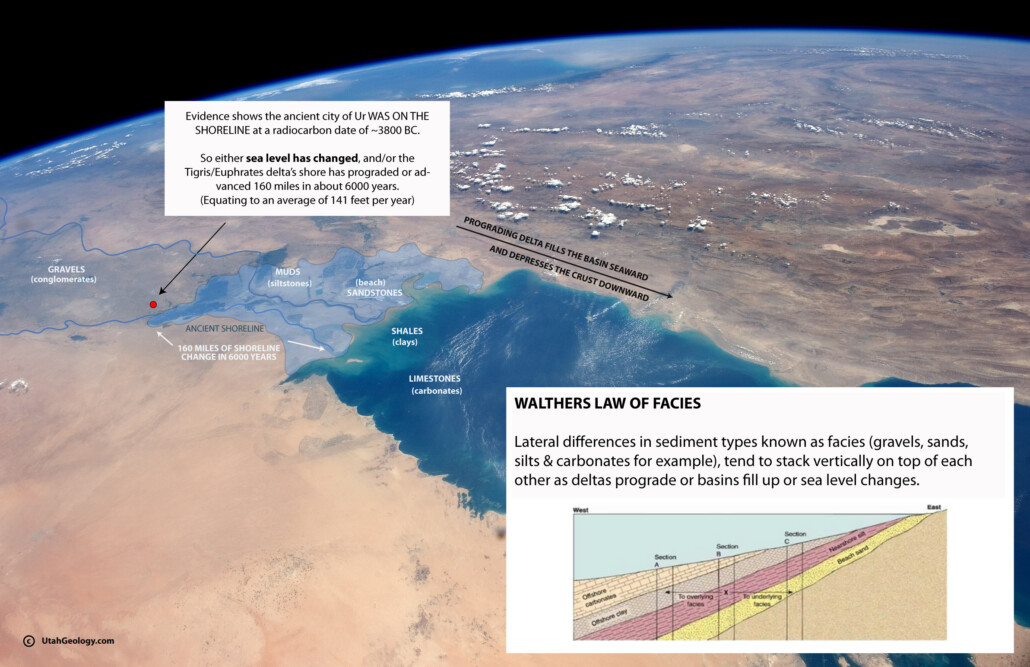
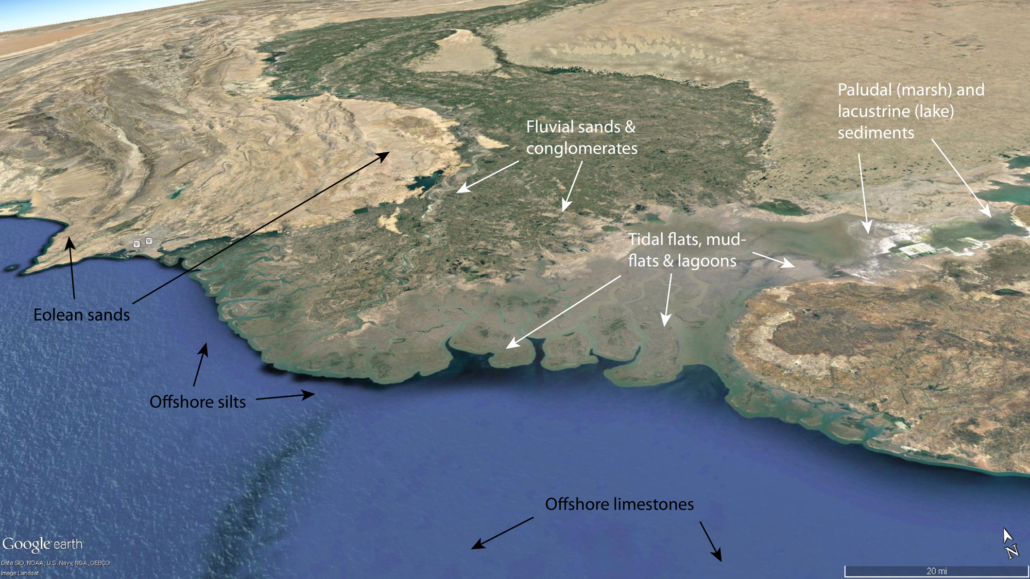
As you can see in the above illustration, a single depositional basin or shoreline often has four to seven separate facies. As sea level rises and falls, or as deltas prograde out to sea, those facies become stacked vertically in a variety of unique ways. Anytime a geologists stands before the coarse grained sediments of a fluvial (stream or river) deposit, they must ask where did the fine grained sediments in this system end up? Where was the shoreline? And as sea-level rose or fell through time are those deposits stacked above or below the one’s I’m looking at?
The Grand Staircase of Utah and Arizona
The Grand Staircase refers to an immense sequence of sedimentary rock layers that stretch south from Bryce Canyon National Park and Grand Staircase-Escalante National Monument, through Zion National Park, and into the Grand Canyon National Park. It is perhaps one of the best locations in the world to study Walther’s Law of facies stacking.
In the 1870s, geologist Clarence Dutton first conceptualized this region as a huge stairway ascending out of the bottom of the Grand Canyon northward with the cliff edge of each layer forming giant steps. By travelling from the bottom of the Grand Canyon, through Zion and the Vermillion Cliffs of Grand Staircase Escalante and onto Bryce, Cedar Brakes or the Cenozoic layers of central Utah one can walk essentially the entire rock record of the last 500 million years since complex life began to evolve on the planet in the Cambrian. By studying these layers geologist like myself can reconstruct what the landscape looked like through time.

Paleogeographic Reconstructions of the Colorado Plateau

Pleistocene Paleogeography
0.01 – 2.5 million years ago (mya)
The Pleistocene (often colloquially referred to as the Ice Age) is the geological epoch that lasted from about 2,580,000 to 11,700 years ago, spanning the world’s most recent period of supposed Northern glaciations. The end of the Pleistocene corresponds with the end of the last “glacial period” and also with the end of the Paleolithic age used in archaeology.
In Utah and the Colorado Plateau, the Pleistocene was a time of greater precipitation and less evaporation as evidenced by Lake Bonneville and many other large Basin & Range lakes glacial features in most the West’s tall mountains.
The Pleistocene is the first epoch of the Quaternary Period or sixth epoch of the Cenozoic Era. In the ICS timescale, the Pleistocene is divided into four stages or ages, the Gelasian, Calabrian, Chibanian, and Upper Pleistocene. In addition to these international subdivisions, various regional subdivisions are often used.
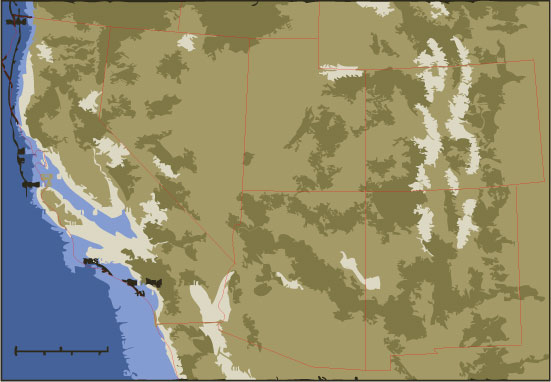
.
Pliocene Paleogeography
2.5 – 5.3 million years ago (mya)
The tectonic patterns of the earlier Miocene continued. Volcanism continued widespread and streams continued to gnaw at the Colorado Plateau. Extension spreads northward as the Mendocino triple junction, the point of contact between the Farallon, North American, and Pacific plates moved northward. Note that Salinia is now in central California. The Cordilleran arc shuts down south of the triple junction as subduction ceases and transform motion begins.

Miocene Paleogeography
5.3 – 23 million years ago (mya)
In the Miocene, volcanism transitioned from felsic intrusives to mafic extrusive volcanism as Basin & Range extension began to rip the Nevadan Mountain arc apart. On the west coast, normal subduction resumed, but only north of where the East Pacific Rise had already collided with North America. Since the Permian or Triassic, the Farallon and related plates were subducted below North America. Once the East Pacific Rise collided with the continent, the westerly plate, the Pacific Plate, came into contact with the continent. Because both the Pacific Plate and North American Plate have westerly components of motion, a new stress regime was established. Extension dominated regions east of where North America contacted the Pacific Plate. A large transform fault system, the San Andreas, was created. Blocks moving northwest along the Pacific side of the fault were caught in a bend of the fault system in southern California. These blocks were rotated in clockwise fashion to form the Transverse Ranges
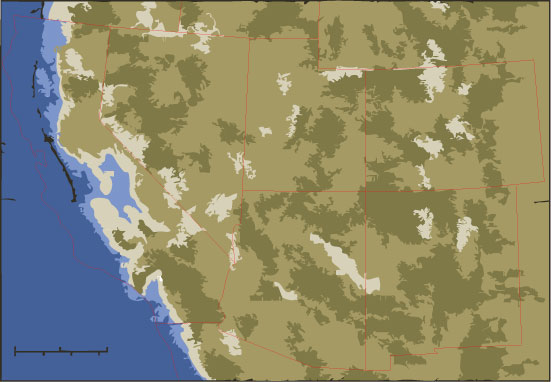
.
Oligocene Paleogeography
23 – 33.9 million years ago (mya)
Oligocene Utah. The Great Drainage reversal finished up and Basins such as the Green River, Claron & San Juan filled in with sediment and rivers were able to find their way through the Nevadan/Arizonan Arc to the Pacific. Volcanism was widespread and extreme across much of the Western Interior. The first stages of the Rio Grande Rift developed as parts of western North America evolved from compressional tectonics to extensional tectonics. California borderlands continued their northward translation and a series of complex basins formed between and east of them. The East Pacific Rise, a Pacific spreading center, neared the coast of southwestern North America. Its impending collision would have profound effects on the evolution of the region
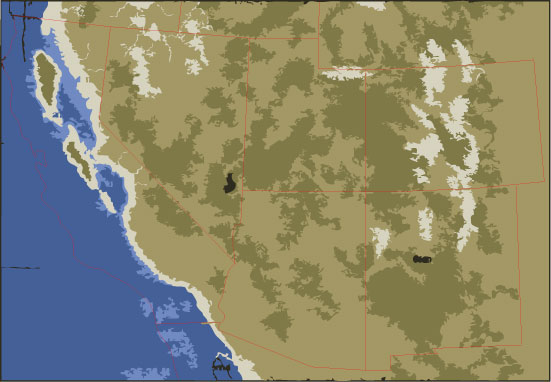
.
Eocene Paleogeography
33.9 – 56 million years ago (mya)
Eocene Utah. As the Rocky Mountains were uplifted, large basins formed and were filled on the pariferee of the Colorado Plateau. Huge lakes filled the basins during the Eocene. These lakes rapidly uplifted during the Eocene & Oligocene from near sea level to elevations closer to their present-day elevations. A rugged Mountainous arc still existed in Nevada, Western Utah, and central and southern Arizona. Streams drained these uplands through the Colorado Plateau into the lakes. Sometime during the Late Eocene to Oligocene, Central Wyoming rose high enough to reverse drainage through Split Mountain and the Unita Arch from a northern course to a southern course, and on through the newly developed Colorado River drainage.
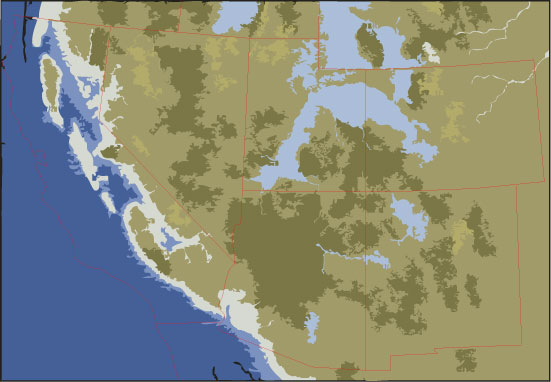
.
Paleocene Paleogeography
56 – 66 million years ago (mya)
Paleocene Utah: The Great Drainage Reversal & beginning of Colorado River.
After studying this topic intently for over 20 years, I’ve come to the conclusion that most my fellow geologic researchers miss the forest for the trees regarding the start date for the early evolution of the Colorado River. They hyper-focus on areas like Peach Springs or hard-to-constrain zircon dates in downstream alluvial deposits, without remembering the most important features which evidence the rivers beginnings–which are 1. The canyons through the upwarps the river flows through and 2. The lacustrine (lake) deposits that always accompany major drainage reversals.
Addressing the former first, its important to remember that some river had to pre-date the upwarps of the Colorado Plateau in order to maintain eroding a coarse & canyon through them as they rose. Let me repeat that. A river HAD TO PREDATE the major Laramide upwarps which they modern rivers currently cut through. There is simply no way around it. (Pun intended). The Colorado River cuts through the Kaibab, Monument, Virgin, Circle cliffs, Uinta/Split Mountain, and Uncompahgre uplifts, and its tributaries cut through the Cockscomb, San Rafael swell and other upwards, strongly suggesting these watercourses were established BEFORE the upwarps began to rise significantly in the Cretaceous & early Tertiary. However, it’s also fairly well established that the general drainage in Utah & the Colorado Plateau throughout the Cretaceous & earliest Tertiary was opposite of present, to the NORTH and EAST from the Nevada & Arizona highlands into the retreating Cretaceous seaway.
So when did the drainage reverse? It’s well-known that major drainage reversals create lakes & lacustrine deposits, and researchers have been looking for these for decades in regard to the debate on the Colorado River’s evolution. Yet to date, the paltry Bidahochi Formation on the Defiance Upwarp is the only proposed candidate for a Tertiary Lake deposit marking the ‘Great Reversal’. But frankly the obvious answer has been staring us in the face the whole time. The Great Paleocene & Eocene lakes of Utah & Wyoming are the evidence of the reversal & beginning of the Colorado River! It was during the Paleocene & Eocene that drainage reversed from Northeastward to Southwestward, and the proto-Colorado River established it its outlet to the Pacific Ocean through a pass in Mountains, much like present Ganges River draining the Tibetan plateau through the front range of the Himalayas. Thus as the Nevadan/Arizonan Arc collapsed in the Mid to Late tertiary, the Colorado River had already established an outlet to the Pacific, allowing it to maintain courses through canyons in the afore mentioned raising Upwarps of the Colorado Plateau.
[picture]
.
Latest Cretaceous Paleogeography
72 – 66 million years ago (mya)
Huge changes marked western North America. The Western Interior seaway had withdrawn and in its place were the embryonic Laramide uplifts of the Rocky Mountains. Debate rages over the origin of the Rockies, but the most popular theory states that the subduction of the Farallon oceanic plate under western North America changed to a very shallow angle, perhaps less than 10 degrees. This drove subduction eastward into the Rocky Mountain region and caused the uplifts and plutons there while the Cordilleran arc in California was shut down. Other theories blame collision with Wrangellia and the resulting compression for the Laramide orogeny. Perhaps large fragments of Wrangellia were partly responsible for the shallow angle of subduction.
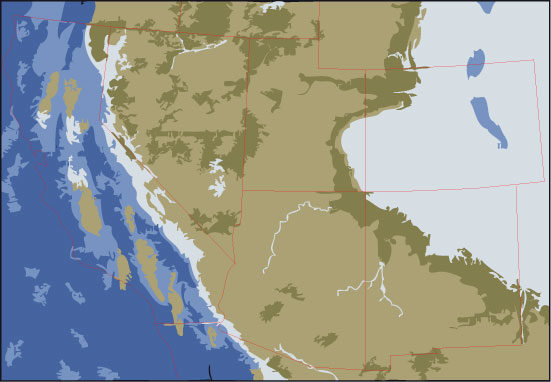
.
Late Cretaceous Paleogeography
89 – 72 million years ago (mya)
The Western Interior seaway slowly retreated to the northeast. Vast alluvial plains marked its past locations. Some of the World’s greatest dinosaur remains are found in these deposits. The Sevier orogeny was at its climax. Regional metamorphism affected western Arizona and eastern California. Paleozoic and Mesozoic sandstone, mudstone, and limestone were metamorphosed to quartzite, schist, and marble. The west coast was marked by strongly oblique collision between the oceanic and continental plates and right-lateral transform faults transported pieces of Wrangellia and other terrains northward along the edge of North America. The Franciscan forearc complex was a broad accretionary prism that was constantly being deformed by complex stresses into a melange’
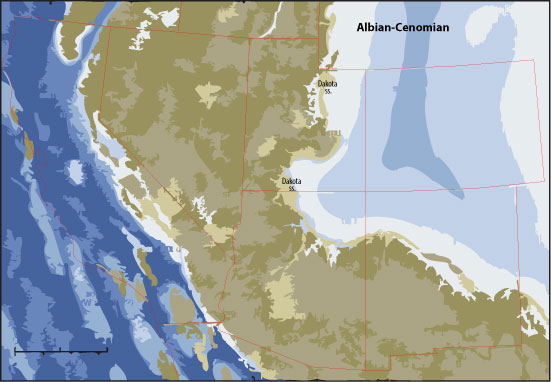
Middle Cretaceous Paleogeography
125 – 89 million years ago (mya)
The Western Interior seaway has expanded to one of the greatest epicontinental seas of all times. It stretched from central Utah to the western Appalachians and from the Arctic to the Gulf of Mexico. The Sevier orogenic belt bordered the sea to the west. This great thrust belt resulted from compression of the Cordilleran arc, perhaps further mitigated by collision with the huge Wrangellia oceanic plateau. The nature of the collision, its exact location, and its magnitude are anything but clear. Pieces of Wrangellia and Wrangellia-like plateaus are presently strewn along the west coast of North America from Mexico to Alaska

Early Cretaceous Paleogeography
145 – 125 million years ago (mya)
The Western Interior was the site of an encroaching epicontinental seaway from the north. To the west lay uplands and a thrust belt in Nevada and western Utah. Transtensional basins in southern Arizona and california were the sites of thick marine and continental deposition. The Cordilleran arc was now a classic continental (~Andean-style) arc along all or most of its extent. The arc consisted of a fore arc-trench system, fore arc basin, and Andean arc. The fore arc-trench was the site of the famous Franciscan melange’. The Great Valley sequence was deposited in the fore arc basin and the Sierra Nevada batholith complex formed in the bowels of the arc
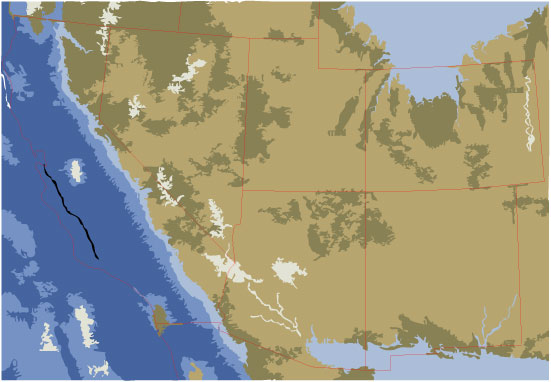
Late Jurassic Palegeography
163 – 145 million years ago (mya)
The uplift in Nevada reverses stream direction across the region and the Morrison fluvial system expands eastward across the Western Interior. Stresses related to the opening of the Gulf of Mexico oceanic basin caused oblique, transtensional basins to form across the southwest portion of North America. Thick continental and later marine deposits filled these basins. The collapse of Stikine arc against Quesnell and perhaps the initial collision of Wrangellia trigger the first phase of the Nevadan orogeny.
Middle Jurassic Palegeography
174 – 163 million years ago (mya)
A long, narrow, epicontinental seaway extends into the Western Interior from the north. Dunes rim the southeast margin. The elements of the McCloud arc collapse against the continent and thrusting in Nevada creates uplands. The large Wrangellia oceanic plateau approaches from the south. Most interpretations consider Wrangellia to be an exotic terrain. However, the details of the history of this terrain and its collision with North America are greatly debated
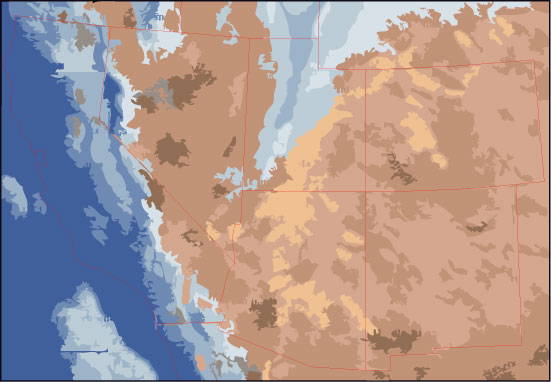
Early Jurassic Paleogeography
201 – 174 million years ago (mya)
The great Navajo sand sea has spread across much of the Wertern Interior. A continental arc has developed across the Southwest and some Navajo dunes spill westward into the topographically low arc. Farther north the arc is off shore separated from the continent by a back arc basin. The Stikine and Quesnell elements are separated by the Cache Creek interarc basin.
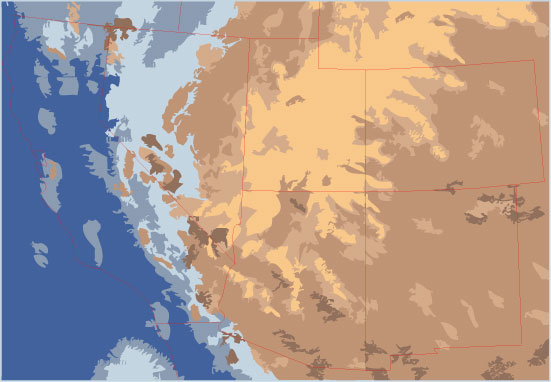
Late Triassic Palegeography
242 – 201 million years ago (mya)
The Chinle fluvial system covered much of the Western Interior. Chinle rivers were sourced in remnant highlands of the Appalachian Mountain system. As the Cordilleran arc developed, a new back arc basin formed behind the McCloud arc.
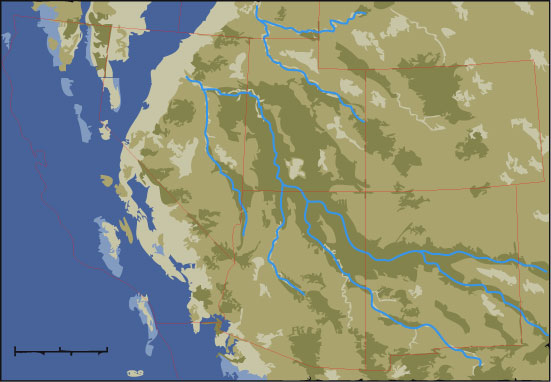
Early Triassic Palegeography
251 – 242 million years ago (mya)
A broad fluvial and shallow marine depositional system (~the Moenkopi Formation) covers much of the southern Western Interior. To the west, the Stikine and Quesnell elements of the McCloud arc collide and in turn collapse the Havallah back arc basin as the Sonoman orogeny continues. The Cache Creek forearc complex is trapped between the two arc elements.
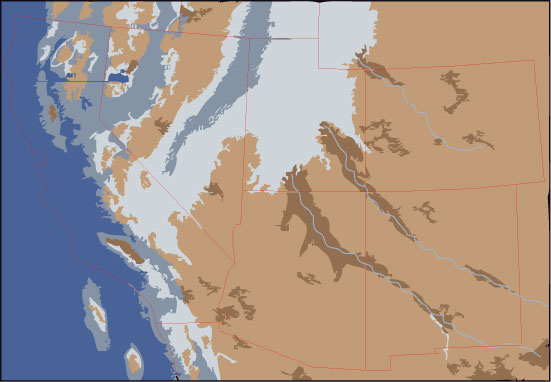
Permian Paleogeography
298 – 251 million years ago (mya)
Parts of the Ancestral Rockies remain high and shed sediments into adjacent basins. The Havallah back arc basin expands over the site of the previous Antler Mountains.
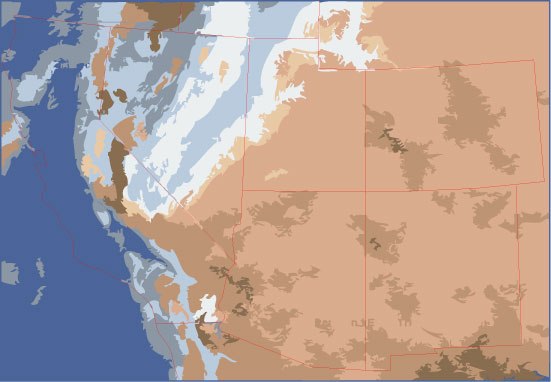
Pennsylvanian Paleogeography
323 – 298 million years ago (mya)
Huge changes in paleotectonics from earlier periods affected western North America. The Ancestral Rockies rose across the southern Western Interior. The Antler Mountains were already being worn down by erosion and even began subsiding in some areas. A marine basin covered most of western Utah and eastern Nevada.
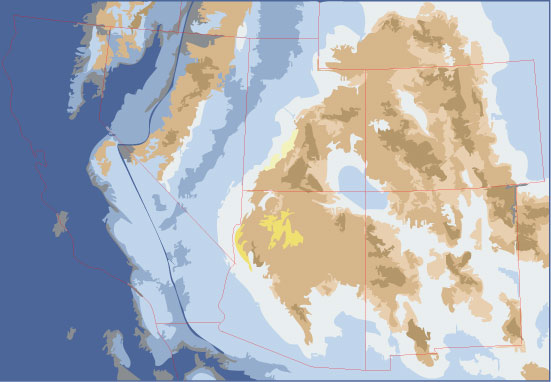
Mississippian Paleogeography
358 – 323 million years ago (mya)
The colliding Antler arc shoved strata deposited in deep water over the continental shelf to form the Antler orogeny. The weight of the thickened crust caused eastern Nevada and western Utah to subside and thick Upper Devonian and Lower Mississippian strata formed there. Farther east a broad carbonate shelf blanketed much of the Western Interior.
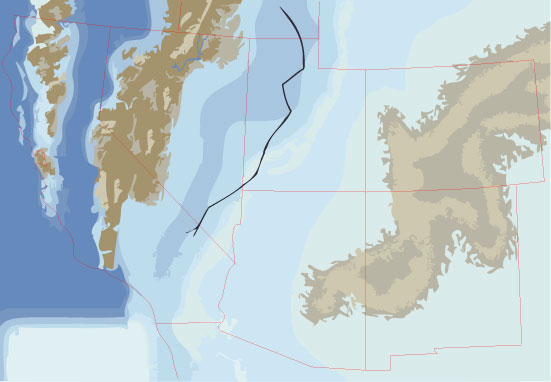
Devonian Paleogeography
419 – 358 million years ago (mya)
Carbonate deposits continue to dominate the continental shelf. Significant changes in sea level have incised canyons into the shelf.
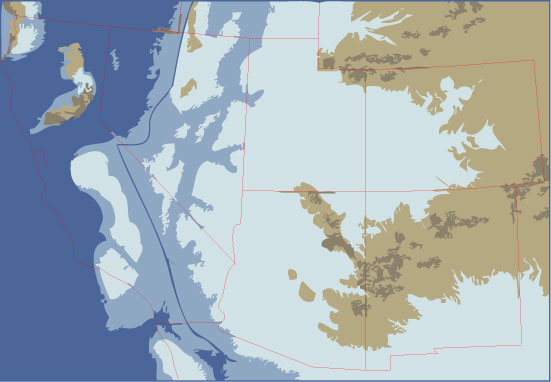
Silurian Paleogeography
443 – 419 million years ago (mya)
Shelf carbonates and deeper water shelf margin deposits grade westward into continental rise deposits and oceanic sediments in western Nevada and California.
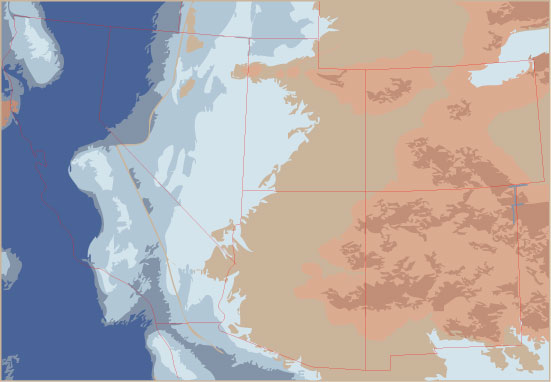
Ordovician Paleogeography
485 – 443 million years ago (mya)
Note the continuation of Cambrian depositional and tectonic patterns. The western view show a rapidly approaching oceanic arc. As the ocean off western North America subducts below the arc, the arc closes in on the North American coast. The area of origin of this arc is unknown but highly debated — some geologist derive it from far across the Paleo-Pacific and others argue for an origin not far off North America.
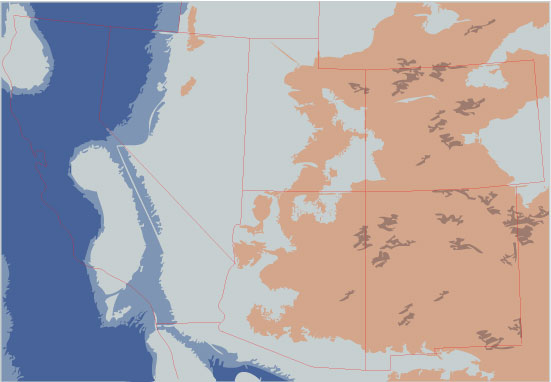
Cambrian Paleogeography
541 – 485 million years ago (mya)
The passive margin setting continued; fluvial and shallow marine sandstone and mudstone grade westward to shelf carbonate rocks. The slope-rise at the continental margin was the site of deep marine turbidity and slump deposits.
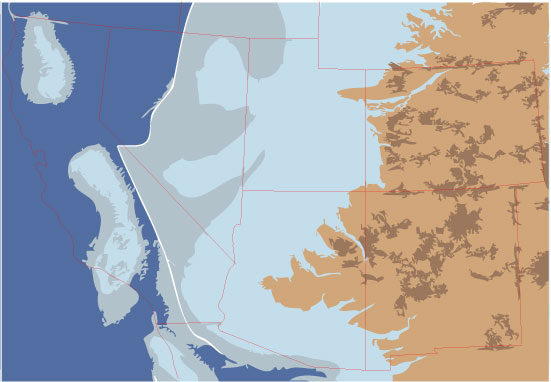
.
.
To Do:
-add a linked table of contents
-add a section on radical theories
-expanding earth (from mantel density flux) as a driving mechanism for plate tectonics, Earth as a rocky gas giant, gradual and catastrophic TPW as driver of orogenesis.
-add a planetary geology section
-add sections for every geologic age. Cover each major formation/group within those sections
–


Leave a Reply
Want to join the discussion?Feel free to contribute!